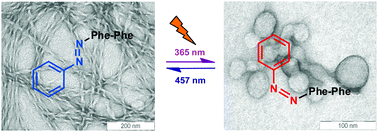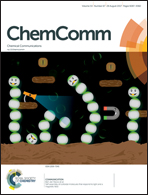Modulating the Phe–Phe dipeptide aggregation landscape via covalent attachment of an azobenzene photoswitch†
Abstract
Synthetic control of peptide-based supramolecular assemblies can provide molecular cues to understand protein aggregation while also inspiring the development of novel chemical biology tools to deliver cargoes inside cells. Here we show that the trans-to-cis photoisomerization of a pendant azo-group covalently attached to a Phe–Phe dipeptide can comprehensively ‘turn-off’ its native fibrillation propensity as well as provide an optical handle to reversibly switch the aggregate morphology from fibril to vesicle.



 Please wait while we load your content...
Please wait while we load your content...